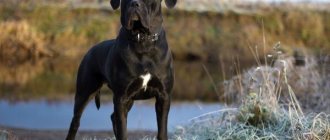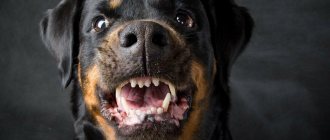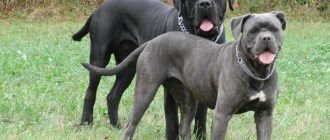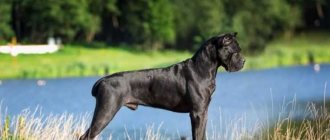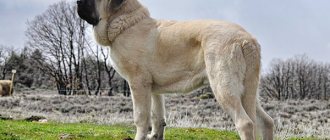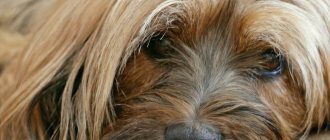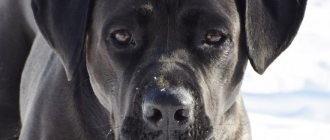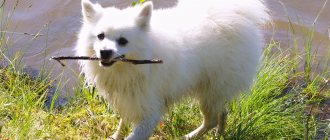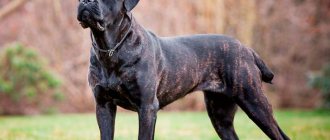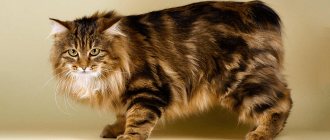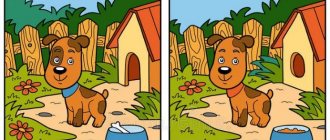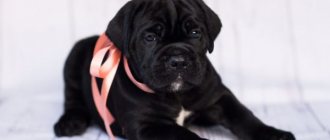How to recognize a purebred dog
The Italian is endowed with developed muscles and strong bones. It impresses with its large size and brutal appearance. A special feature of the breed is its thick neck and wide skull. The folds on the massive muzzle and head form a characteristic pattern.
The Neapolitano Mastiff, properly developed physically, has high-set, hanging, thick ears.
The main breed criteria by which purebred is judged include:
- The height (height at the withers) of an adult dog is between 60 - 68 cm for a female, and 65 - 75 cm for a male.
- Weight - 50 - 60 kg for a female, and 60 - 70 kg for a male.
- The color can be brindle, lead, brown, gray or black. Small white spots on the body are acceptable.
How to choose a puppy
Before buying a puppy, you need to answer the question: “What exactly do you need a dog for?”
Are you going to prepare her for participation in exhibitions, will you choose her for breeding, or do you need her as a loyal friend and decoration of your home. If you want to buy a Mastino for the first two purposes, then you should contact exclusively nurseries and trusted breeders, since in this case the probability of running into a breed of inappropriate quality is very low. Pay attention to the puppy’s behavior - he should not show any aggression, must look healthy and be active. Be sure to examine his eyes, ears and muzzle as a whole; there should be no irritation, scratching or other damage on his body. Check the presence of all accompanying documents.
History and purpose
Their roots go back to the distant past.
2,000 years ago they appeared on the southern side of the Apennine Peninsula. Mastino Neapolitans are descendants of the most ancient fighting dogs - Molossian Danes. These giants easily hunted game for aristocrats or guarded the home of ordinary people, which means they were popular. Take the Attention Test! Find 10 differences! (click right here!)
Find the answer Are you bothered by some problem or question? Enter “Breed” or “Name of the problem” into the form, press Enter and you will find out everything about the issue that interests you.
They began to be evaluated in 1949, after the demonstration of the eight best representatives at an international exhibition. In the same year, the breed was well received by the world community.
Story
Italian Mastiffs are direct descendants of the Tibetan or Molossian Dogo, records of which date back to 1000 BC. In Ancient Rome, these large dogs were used as guards of palaces and temple areas, participated in battles, bear hunts, and performed in the gladiatorial arena. Many graphic images, sculptures, and chronicle descriptions dedicated to the breed have been preserved.
Cane Corso in Ancient Rome
After the fall of the Roman Empire, the breed spread throughout Europe and changed somewhat. They are known to have been crossed with Celtic greyhounds. Chronicle sources from the 14th-15th centuries were discovered describing the participation of massive dogs in baiting game; in some regions they were used in pastures and driving livestock.
During the difficult times of World War II, many breeds of domestic animals were on the verge of complete extinction. This fate did not spare the Cane Corso. In 1973, Professor Giovanni Bonatti and like-minded people attempted to restore the gene pool of the breed. The Quesnel Club of Italy has developed a document approving the standard. By 1992, 500 individuals were registered that could be considered purebred.
The International Canine Organization recognized the breed in 1996. The place of origin of modern representatives is Northern Italy, they are close relatives of the Mastino Neapolitan and descendants of the ancient Allano
.
Italian temperamental dog
The character is surprisingly friendly, which does not fit well with his terrifying appearance.
They are described as “big children who require constant attention.” Mastino Neapolitano knows his owner and remains fantastically loyal to him. He treats guests kindly, but always remains on guard, ready at any moment to protect the property entrusted to him and the life of the owner. Fearlessness, a high pain threshold - this is what they inherited from their ancestors.
The dog will behave calmly, being in the comfort zone. He is inclined to contemplation, which is why they are also called philosophers.
A kind, sociable, caring dog will be given to the person who treats it with respect and pays due attention to its care.
Mastino Neapolitano's jealousy is expressed aggressively, and this trait is aggravated by his excellent memory. They are not recommended for families that have:
- Child under twelve years of age;
- Another dog.
The jealousy of these huge dogs will cause various unpleasant and dangerous situations.
Description of the Cane Corso breed
According to the breed standard, the Italian Mastiff is positioned as a multidisciplinary working dog with a variety of uses. The breed is primarily focused on security and protection, but the Cane Corso can be seen in police service and during search and rescue operations. They are increasingly kept as pets and companion dogs.
Appearance
The Italian Mastiff is a large, athletically built, strong and athletic animal, remaining graceful and elegant with a massive but not heavy bone structure and well-developed prominent muscles . The overall strong silhouette is rectangular, the body is slightly elongated (the height at the withers is approximately 10–11% less than the length of the body) with a straight, muscular back, clearly defined high withers (above the croup line), a well-developed, widened chest reaching to the elbows, strong, short loin, wide, elongated, slightly sloping croup and moderately tucked belly.
The Cane Corso's physique is strong and muscular, but at the same time graceful and elegant.
Breed standard:
- The large head of the molossoid type with a wide skull, a convex forehead and a pronounced tubercle at the back of the head is set on a strong, muscular neck. A deep groove runs from the clearly visible stop to the middle of the skull. Square (length equal to width), powerful muzzle, half as long as the skull.
- The nose is large, the nostrils are well opened and large. The mirror is pigmented black (color to match the mask is allowed), located at the same level with the straight bridge of the nose.
- The curved jaws are powerful and large with a slight overshot (up to 5 mm). A direct bite is undesirable, but acceptable. The upper lips hang down, forming U-shaped jowls and covering the lower jaw.
- Slightly convex, but not protruding, the oval eyes are of medium size, set wide and straight, with close-fitting eyelids. Iris of dark shades (the darker the better). The look is penetrating, intelligent, lively and attentive with some sadness.
- The ears are medium-sized, high and wide, triangular in shape, hanging on cartilage. Cannot be docked (previously docked under an equilateral triangle).
- The tail, strongly thickened at the base and set high, is left at a natural length (in the previous edition it was docked to the 4th vertebra), carried high, but never raised vertically. Doesn't twist and doesn't roll over your back.
- The limbs are very muscular, thick and strong with neat oval paws and toes gathered in a tight ball (the hind ones are a little more loose).
- Height at the withers: females - 60–64 cm (acceptable 58–66 cm);
- males - 64–68 cm (acceptable 62–70 cm).
- females - 40–45 kg;
The Cane Corso moves confidently, widely and sweepingly. All movements are clearly adjusted and balanced. Trot is the preferred gait.
The coat is very dense, short and shiny with a weak undercoat. Thick skin fits tightly to the body.
Acceptable colors:
- dark fawn;
- black;
- dark gray (lead);
- light fawn;
- light gray (mouse);
- red fawn;
- brindle (all shades of gray and reddish-yellow).
The standard allows seven types of colors for the Italian Mastiff
Gray or black masks, which are found in brindle and reddish (fawn) individuals, do not rise above eye level. Small white spots are allowed on the paws (toe tips), bridge of the nose or chest (tie).
A dog trainer I know told me that after the war, the Italian mastiff was mixed with a variety of breeds, and therefore, in appearance, dogs of different colors can be very different from each other. For example, red animals took more from Staffies and Boxers, while gray animals are clearly closer in build to Mastino, and black ones generally look more like Great Danes. Disputes about the intricacies of the breed standard constantly occur, because the breed has not yet been fully established and formed. Sometimes real battles happen at exhibitions.
Disadvantages and disqualifying vices
Minor faults or defects can be considered any deviations from the breed standard requirements; their severity is determined depending on the degree of manifestation, as well as on their effect on the well-being and health of the animal.
More significant vices will be:
- excessively prominent and developed zygomatic arches;
- problems with the jaws (overshot more than 5 mm, scissor bite);
- dewclaws;
- deviations in growth (less or more);
- poorly pigmented nose;
- tail set vertically or wrapped in a ring;
- incorrect gait (trot mixed with ambling);
The grounds for disqualification are:
- uncolored nose;
- poorly pigmented eyelids;
- undershot;
- strabismus;
- Roman or lamb nose (with a hump or hollow);
- whitish eyes (iris with bluish splashes);
- the coat is elongated, fringed or cropped;
- the tail is short or absent;
- any other colors not specified in the standard;
- presence of large white marks and spots;
- cowardice or aggressiveness;
- obvious deviations in behavior or physical structure.
Character and psyche of the breed
Cane Corsos are distinguished by their poise, masculinity, strong and decisive character, as well as pronounced leadership qualities. Thanks to their developed sense of territoriality, they are able to tirelessly and around the clock monitor the area entrusted to them, guarding the owner’s property and protecting the owners themselves from possible intruders. They treat strangers with caution, do not show unnecessary aggression, but do not let them out of sight, constantly being in a state of combat readiness. The deep barking of these dogs can only be heard in the event of a real threat. It is impossible to distract them from performing their duties, even using a treat.
The Cane Corso is always alert and always watching everything.
Corso is famous for his incorruptibility and perfectly understands the difference between real danger and a game, reacting instantly and decisively. For a pet, the whole world is divided into friends and strangers, and in some incomprehensible way he intuitively understands this. In relation to the family in which he lives, the Italian mastiff experiences the most tender and reverent feelings. The animal becomes so attached to its owner that it is extremely difficult to bear separation from him.
Cane Corso are considered a one-master dog because they are loved only once.
With early socialization and good upbringing, the pet easily gets along with other pets and will never rush in pursuit of a street cat. However, conflicts based on dominance are possible between male dogs, especially among young animals and adolescents. This never happens between bitches. The sociable and active dog happily frolics with children, sometimes allowing them to play rather daring and rude pranks. But it is still not recommended to leave them alone for a long time.
Proper care and necessary conditions of detention
When you are planning to get this pet, make sure that you can create comfortable living conditions for it.
It requires special conditions and careful care, which is not so easy to maintain. But it's worth it! What does a dog need? To maintain it, you will need a large area where you can run freely. He is not particularly clean - he scatters food and splashes water while feeding. But the reason for this is not natural harmfulness, but the specific structure of the muzzle - he simply cannot do otherwise.
It is advised to feed him in a specially designated place, which can be simply washed after eating (several times a day).
He has increased salivation.
He is not suitable for living in city high-rise buildings - he will feel constrained. He was born for a free life in a spacious cottage or country house.
The next important point is constant monitoring of skin folds and the condition of the coat. You will have to trim his nails regularly, and you can only bathe him if absolutely necessary or if he is very dirty.
Diet and what you can't give up
The Italian Mastiff needs high-quality nutrition - complete and balanced, but moderate.
The diet of an adult dog and a puppy is very different. A young dog that has not yet reached maturity requires food rich in microelements. This has to do with size. The larger the animal, the stronger its musculoskeletal system should be. It is important not to overfeed the puppy. With a weak skeleton, he can simply “fall on his paws.”
It is important for puppies to include additional vitamins and minerals in their food, especially if the type of feeding is natural. Vitamin and mineral supplements help:
- Strong nervous and immune system;
- Correct formation of joints that will support a large individual.
The puppy will develop properly only when he receives enough protein. Protein should make up at least half of your daily nutrition.
Puppies under 3 months of age need to be fed 4 times a day. From this age, the period between feedings is gradually increased, approaching two meals a day.
An adult dog is fed a balanced (professional) food that provides the required amount of nutrients. Otherwise, he will become lethargic, and his health will deteriorate. You can use natural products, which your veterinarian will help you choose.
It is necessary to ensure free access to drinking water - the Italian Mastino Neapolitano consumes large amounts of it.
The largest Neapolitan Mastiff
The Guinness Book of Records records the heaviest dog in the world, named Hercules, of the Neapolitan Mastiff breed. Its owner was the British athlete Joe Flynn. The Neapolitan mastiff Hercules weighed almost 128 kg, and the volume of his neck was 96 cm. During the day, such a pet ate about 1.5 kg of dry food, and every evening the owner treated him to a good piece of steak. This Neapolitan mastiff and the man, according to the owner himself, were best friends and comrades-in-arms.
Trainability and whether the dog can be trained
Mastino Napoletano will not cause any trouble due to its calm disposition and natural intelligence.
Training will turn into an exciting game - they quickly remember everything. They begin to be accustomed to the simplest commands at 3.5-4 months. But, you should not delay the start of training - without receiving proper education, the dog will become uncontrollable.
Human communication has a beneficial effect on the baby. He must constantly be among people, which will help overcome his instinctive suspicion.
Guests should be warned that it is dangerous to provoke a dog. They must give up aggression towards her - active gestures, intrusive games or affection. The dog should not be beaten or scolded loudly. Italian Mastino Neapolitano simply does not notice guests if he does not sense danger.
Character
Representatives of the breed have a calm and balanced character. Their main feature is the ability to intuitively distinguish between friends and enemies. This dog will never attack or bite without reason, but if it senses an invasion of its territory, it will act at its own discretion. Italian mastiffs are very smart and intelligent; this nobility is surprisingly combined with a strong constitution. They will never demand attention, whine or bark for no reason. They are very attached to the family, especially children. They are devoted and faithful to their owner, and are acutely sensitive to separation.
You cannot bribe a Cane Corso with a tasty morsel and you cannot distract him from his main duty - to protect his family. This pet will not stop when it comes to protecting its boundaries and those it loves. Due to the increased devotion and attachment that develops from puppyhood, the dog experiences separation from its owner very hard.
If you want to buy an Italian Mastiff, think carefully. Don't give in to the impulse of the moment. A Cane Corso can only fall in love once, and if you betray him by being disappointed in the dog's upbringing, you will ruin the dog's life forever.
Cane Corso are dogs with an iron character and will, and are very emotional. Puppies require the constant presence of the owner, with whom they must be in an equal relationship. Accommodation with other animals depends on the character of the dog and neighbors, but, as a rule, no problems arise. They treat children exceptionally well, only a dog will allow a child to do whatever he wants with him, he will never knock him down or scare him, and he gets very worried when he hears a child crying. Cane Corsos bark only when there is a real threat.
Tendency to diseases and what to fear
The Molosser breed group, which includes the Neapolitan, is distinguished by its good health. Problems usually arise from improper care, maintenance or lack of attention. Proper balanced feeding is important in maintaining health.
The onset of the disease is signaled by lethargy and low activity of the bird. If you receive such a signal, contact your veterinarian.
An advanced disease becomes chronic and curing it becomes much more difficult and expensive. But if you do not take the necessary measures to eliminate it, it will also become the cause of the dog’s premature death.
Of great importance in a competent approach to keeping a dog is the prevention of various infectious and invasive diseases. You can find out about it from your veterinarian before purchasing a puppy.
When the moment of purchase comes, you need to make sure that the baby has had preventive treatments and vaccinations, and inquire about the health of the parents of your future dog.
Common diseases:
- Allergic reaction.
- Skin diseases.
- Excess weight is a consequence of overeating or poor diet.
- Bursitis - due to the large size of the individual. Lying down heavily, the mastif hits the hard floor with its elbow joints. Liquid begins to collect in them, and large blisters form on the elbows. A soft floor covering will help prevent their occurrence.
- Pain in muscles and joints, sometimes developing into hip dysplasia. It occurs when puppies grow quickly (increased body weight), but muscles, joints and ligaments do not have time to develop (development is delayed).
The life expectancy of Neapolitans is on average eleven to fifteen years with appropriate care and maintenance.
Necessary care
Find out what kind of dog care is needed:
Nutrition: what to feed?
- Cane Corso often has allergic reactions to certain foods, so you should start feeding the dog carefully so that it is possible to identify a possible allergen and remove it from the dog’s diet. It should be noted that due to this problem, owners have to buy specialized hypoallergenic food, which is an expensive pleasure.
- Weight control is necessary . The Corso Italiano loves to eat, so the owner must monitor the amount the dog eats, divide the food into 2-3 meals per day and in no case overfeed.
- The amount of carbohydrates should correspond to the energy consumed. The less physical activity a dog does, the less carbohydrates it needs.
- What is the best food for Cane Corso? Natural food, even of the best quality, does not always contain a sufficient amount of microelements and vitamins for a dog. Therefore, it is better to give preference to premium industrial food for Cane Corso (Royal Canin, Pro Plan and others).
- If your dog gets tired of dry food, you can periodically dilute the diet with canned food and preserves from the same manufacturer.
Feeding and nutrition of the puppy
Combing and washing
Since the dog is very shedding, and throughout the year, it will have to be combed daily with a hard brush. The dog should be washed as needed (there is no specific framework).
Proper care of a dog's fur: what to comb and how to comb out tangles?
Video
By contacting the nursery, you can assess the psychological state of the puppy yourself by conducting a stability test.
It is enough to monitor the behavior of the animal when a stranger appears and their reaction to sudden movements or sounds. An adequate Italian Mastiff will begin to show curiosity, and after making sure that there is no threat to him, he will offer to play, like all children. Don't buy a puppy that will attack or hide and run away.
The key to the health of a young pet is a good appetite, calm juice and increased activity. Choose a dog that:
- Vaccinated;
- Moderately well-fed;
- Has clean ears and eyes, fur and skin.
At the slightest deviation, it is better to look for another option. Make sure you have the required vaccinations. And if the animal is in quarantine associated with one of them, it is better to leave it in the nursery.
If possible, meet the parents of the baby you plan to take home.
Having chosen a nursery, the owner purchases a puppy with a full set of documents, which includes a veterinary passport and a puppy card. The nursery specialists will continue to help you cope with emerging questions or problems.
For the opportunity to get a Neapolitano Mastiff puppy, you will have to pay from forty to one hundred thousand rubles.
Choosing a puppy
The Cane Corso is now a very fashionable and sought-after breed, so there are many people on the market who want to sell a Corso-like dog or a mixed breed, passing them off as a purebred animal . To avoid becoming a victim of deception, you should choose a puppy from a good specialized nursery or from a reliable, trusted breeder who has an excellent reputation and many positive reviews.
Before buying a baby, it is recommended to personally look at both parents, and also evaluate the conditions in which the dogs are kept. It is necessary to check the entire set of documents provided: puppy card, pedigrees of the parent couple, breeding patent, exhibition diplomas, etc. It is advisable to verify the legality of the mating (this should be recorded in the club journal).
It is very difficult to distinguish a small Corso from other mastiff-like dogs, since even in the same litter, puppies can be strikingly different from each other. Only a very experienced cynologist expert who understands all the intricacies of this particular breed can do this.
Cane Corso is very popular now, so finding a good puppy is not difficult
Price of a puppy of this breed
The cost of an Italian Mastiff greatly depends on its class and the title of its parents. A puppy with the prospect of conducting exhibition activities (show class) is valued at no less than 60–70 thousand rubles, and sometimes more. An individual intended for breeding (breeding class) will cost a little less - 45–50 thousand rubles. A pet-class puppy (for home, for family) already costs about 20–30 thousand. A baby without documents can be purchased for 10–15 thousand rubles.
Vaccinations
All vaccinations must be performed under the supervision and recommendation of a veterinarian. Among the mandatory vaccinations for these dogs, only vaccination at two months of age against glanders, leptospirosis and hepatitis is distinguished. All other vaccinations, for example, against rabies or parvovirus, are desirable, but not mandatory.
Remember: by purchasing such a dog, you first of all buy yourself a faithful comrade and family member, and only then a watchman for your home. Love your pet with all your heart, and he will return this feeling to you a hundredfold.
Puppy training
Training a Cane Corso should begin from the seventh month of a puppy’s life (earlier there is no point due to an unformed psyche) and lasts as long as you have a pet. An adult dog has a high ability to learn, developed intelligence and excellent intuition (especially in the territory where they live). Even with apparent calm, the pet is in fact always on the alert. Film your dog so you can evaluate it and yourself later.
Cane Corso puppies must be raised using several methods, among which you must choose the most suitable one for your pet.
Carrot and stick (feed = encourage), expulsion - these are the main techniques in training such a dog. Commands must be spoken clearly, confidently and loudly. It is better not to feed the puppy before training. Physical punishment is generally unacceptable.
Bathing, brushing teeth
These dogs should not be bathed without a special reason. This is due to the fact that their fur is covered with a fatty layer, which is designed to protect against insect bites. During the bathing process, especially if the dog is shampooed for a long time and thoroughly, this layer can be unintentionally broken or completely removed.
It is strictly contraindicated to bathe dogs of this breed until they reach the age of 1 year, since this risks getting water into the ear canals that are not yet fully formed, which will inevitably lead to the development of infection.
Brushing your teeth is a must for this breed of dog, as its representatives are prone to the development of tartar, which subsequently leads to injury to the gums and exposure of the necks of the teeth. You need to brush your teeth with a toothbrush and toothpaste for dogs once a week. It is worth starting to accustom the puppy to this procedure immediately after purchasing it.
The ears of Neapolitan Mastiffs do not have a pronounced muscular and cartilaginous system and simply hang; their ear canals require regular toileting. Cleaning is carried out using cotton swabs on which lotions are applied at least once a week. It is necessary to regularly “ventilate” by folding the outer edges of the ears and fixing them on the head with an elastic band. You can use preventive talc powders that will help prevent the occurrence of inflammatory processes in the ear.
The eyes of this dog breed are a fairly problem-free area, and they do not require additional care. If you notice that they have begun to water, turn sour, or have found signs of inflammation on the eyelid, you can begin to wash them with special lotions.
Animal character
The Italian Mastiff has guarding qualities, is non-aggressive without reason, and has a herding instinct. Shows friendliness and devotion to all members of his family, especially children, and has intelligence, due to which he learns quickly. The dog is balanced and will not harm guests if its owners treat them well. It can attack only during aggressive actions, having received a command from the owner.
They are not inclined to lead in the family; they perform well in the role of a subordinate.
The Cane Corso is large in size, requires certain dog breeding skills, and is not suitable for beginners. Training for this breed is mandatory and requires physical activity.
There may be problems in socializing the animal; more often it is intolerant of other people's dogs, although it can get along quite well with other types of pets.
Color and coat type
The breed has no undercoat. Due to the presence of guard hairs, the skin is protected. The coat is thick, straight, hard, with an elastic structure, and fits tightly to the skin. When choosing an individual, study its color. There are dogs with noticeable incomplete pigmentation of the nose, puppies with white markings on the chest, paws, and a light mask on the face. These signs are shortcomings, so refuse to purchase.
Quality individuals are:
- Reddish hue: from rich brown to lemon, pink.
- Gray color with or without tint: there is a gray-fawn tint, color from rich, deep, dark gray to bluish.
- Brindle: One of the shades has dark stripes.
Relationships between dogs and people
The main difference between the breed is its complete dependence on its owners. When communicating, you will feel reciprocity. The dog is observant: it stays near the owner for a long time, watching what each of the family is doing. Mastino strives to please his owners in everything. If you want to leave the house to the dog, he will take care of the safety of his property and children. Mastino will care, tolerate, and calmly treat babies.
Aggression and bitterness are shown towards ill-wishers: if family members are in danger, the dog will give its life protecting its owners. Many owners claim that Mastinos are able to think and communicate with their owners: a person talks about his experiences, and it will seem that the dog listens and understands everything. When communicating with Mastino, keep your distance, because too close proximity can subsequently provoke jealousy in dogs: they react poorly to their owners’ communication with other animals and strangers.
Characteristics: pros and cons
Let's look at the detailed characteristics of dogs:
pros
- Dogs are very smart . They immediately get used to the owner and his family. There is no need to instill special socialization skills in them. They are also very easy to train. They can often do what the owner says the first time. If the owner brings a person into the house and tells the Corso that this person is a friend, then one should not expect aggression from the dog.
- Ukane Corso has a great character! They get along very well with small children . We are ready to endure all their antics and games.
- They get along well with other pets , including cats.
- They have a sense of proportion. This means that the Italian Mastiff will never cause any harm during play. But in case of danger it can literally tear a person apart.
- Wonderful security guards . The breed's ability to guard is inherent at the genetic level.
- During walks, they always watch the owner, as a result of which they rarely get lost .
- During estrus, bitches take care of themselves independently . The owner may not even notice that his female dog is in heat. These dogs tolerate heat calmly.
Cons of the breed
- Cane Corsos have an interesting character trait: they are very dependent on their owners . It is better for elderly people and workaholics not to get such a dog, as they will not be able to pay the necessary attention. Also for this reason, it is very difficult to leave a pet for a long time (leaving somewhere for a long time) - the animal is very sad.
- Traumatic . If the Corso gets angry, you can get injured, which can even lead to disability and death.
- Sheds a lot.
- Requires physical activity , as the dog is very active.
Wool is everywhere, bring a vacuum cleaner: shedding in dogs
Puppies
Get ready for the giant dog to take up a lot of space in the house. He sheds, snores when he sleeps, and at a young age he is sloppy: he scatters food around bowls and stains things with drool, knocking over objects.
When choosing, examine individuals for compliance with established standards. It is better to buy puppies from specialized nurseries. If you are interested in a reduced price, then look for individuals in bird markets, according to advertisements. Meet the puppy before purchasing. Often their age is 2-3 months.
Research in advance:
- Individual passport.
- Appearance of the puppy (give preference to beautiful, healthy-looking, clean and well-groomed individuals).
- Conditions for keeping the baby and his parents.
- The mental state of the puppy - he should be cheerful and active.
- Hind legs: remember that many babies suffer from dysplasia - a congenital disease associated with changes in the shape and structure of cells and tissues.
Buying a Mastiff
Before buying, decide for what purpose you need a dog - for home, protection and comfort, or to conquer exhibitions. In the first case, a puppy can be bought through an advertisement, but for a show-class pet you will need the appropriate documents (pedigree), which are issued only by nurseries and breeders.
Mastiff puppy
The price for a show class dog, as in the photo above, starts from 30,000 rubles, but in some regions it can reach 70,000 rubles. Of course, everything depends on the puppy’s parents, and if these are titled champions not in the first generation, then you can imagine what valuable genes the puppy carries and the corresponding price.
But by advertising you can save a lot, but it is important to remember that a dog is valued primarily not by money, but by character, and we must not forget that this is a living creature that expects affection, warmth and care from us.
And remember - we are responsible for those we have tamed!
